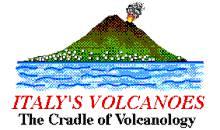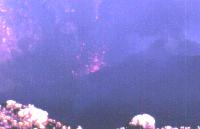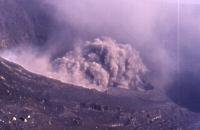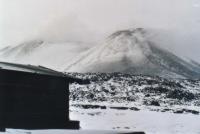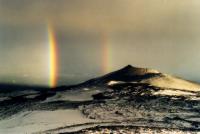|
Archived Etna news
|
Do you plan to visit Etna
in the near future?
Check the weather
forecasts for the Etnean area!
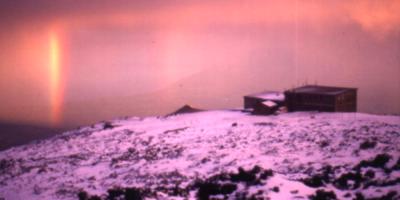
The incredible view
of snow on Etna on the evening of 24 July. The building visible in the
image is the Torre del Filosofo mountain hut (at about 2900 m elevation).
A brilliant rainbow is visible at left; the bay of Catania can be seen
in the background.
|
WARNING: Access to the summit craters is again becoming INCREASINGLY DANGEROUS. Explosive activity has resumed within the Voragine and the Bocca Nuova, and bombs are ejected beyond the crater rim. Magmatic activity is also occurring deep within the active pit of the Northeast Crater which in the past has been the site of violent eruptive episodes. Besides this, weather conditions are often unstable, even during the summer (as experienced just on 24 July 1999). Any person who enters the area beyond the Torre del Filosofo mountain hut (2900 m elevation) goes at his/her own risk and is not covered by any insurance in case a rescue operation (e.g., with helicopters) is necessary. The same is true for those who try to get close to the still-active effusive vents on the Valle del Bove slope. |
Update on the activity on 28
July 1999. Etna's summit craters were visited
today by Boris Behncke, Carmelo Monaco and Angelita Rigano (Dipartimento
di Scienze Geologiche, University of Catania) and others. Deep within
the central pit of the NE Crater there were near continuous detonations,
quite a different sound from the continuous, surf-like sound heard in
the same pit early this month. However, no ejecta were thrown to the
height of the rim of the pit, but a dense plume heavily charged with
sulfur dioxide was emitted, making observations of the pit's interior
impossible and rendering the stay on the crater rim highly unpleasant.
Within Bocca Nuova, explosive activity occurred deep within the
two main vents in the northwestern and southeastern parts of the crater.
While no pyroclastics were seen to rise above the rim of the northwestern
vent, the southeastern vent produced near continuous emissions of brownish
ash which became more forceful when loud roaring explosions occurred
at depth. The most impressive activity occurred at the Voragine
whose central vent produced powerful explosions and at times prolonged
fountains of incandescent bombs, some of them up to one meter across.
Some of the explosions were quite violent, ejecting bombs to about 100
m above the crater rim. No ejecta fell outside the crater, and only
a few fresh bombs, probably ejected a few days ago, were found on the
western crater rim, about 150 m from the active vent. Within the crater,
however, bombs had fallen abundantly, especially in the northern part
of the crater floor, so that any approach to the vents across the crater
floor is absolutely impossible. Many eruptions were accompanied by acute
roaring noises indicating high-pressure gas emission from the top of
the magma column in the vent, which has risen by tens of meters since
last observed directly on 6 July. There was apparently no eruptive activity
within the "diaframma vent". No direct observations were made
at the SE Cone which is believed to be inactive for the moment.
At the 4
February fissure, lava emission continues at low rate. One area
of effusive activity lies on the northeastern side of a large tumulus
that has grown about 100 m downslope from the upper hornito cluster
since late June. One narrow (about 0.5-0.8 m) flow issued from a small
effusive vent and flowed through a channel with unusually high walls
(up to 1 m above the flow surface) while a much larger flow broke through
the southern base of the channel wall, feeding a flow 1.5 m wide that
extended eastwards.
The observations made today confirm once more that the activity in the
summit craters (NE Crater, Voragine and Bocca Nuova) is gradually but
steadily increasing while there are no significant changes to the effusive
activity at the 4 February fissure. Eruptive activity is definitely
taking place in three of the four summit craters, and it is close to
the surface in the Voragine. This crater might thus be the one to produce
more spectacular activity in the near future, but (unconfirmed) reports
about pyroclastic ejections from NE Crater about one week ago may indicate
that this crater shows the highest levels of activity since about one
year.
Observations
on 24 July 1999. Boris Behncke (Dipartimento
di Scienze Geologiche of Catania University) and Giuseppe Scarpinati
(L'Association Volcanologique
Européenne, Paris) made
an attempt to reach the summit craters
on the afternoon of 24 July. The visit was severely hampered by adverse
weather conditions, and no direct observations of the activity in the
craters could be made. When arriving at the Torre del Filosofo mountain
hut (which stands about 1 km south of the SE Cone) with a group of about
15 tourists, hail began to fall, followed by severe storms and a true
blizzard (this is possible even in July!) accompanied by lightning flashes,
so that everybody had to take refuge in the small wooden shack of the
mountain guides next to the Torre del Filosofo building. While the tourists
were later brought back with the tourist jeeps, Behncke and Scarpinati
and a group of the French organization "Aventure et Volcans"
stayed at Torre del Filosofo, watching the rare spectacle of a snow
fall in July rather than any volcanic activity (a few glimpses of small
lava flows on the active flow-field only 500 m away could be obtained
anyway). At sunset, the whole landscape of Etna's upper 1000 m was bathed
in an eerie gloom, with a strikingly luminous rainbow, Etna's shadow
cast onto a dark wall of thunderstorm clouds, near-continuous snow falls,
and lightning strokes.
Behncke and Scarpinati decided to leave Torre del Filosofo and to return to Acireale, near Catania, when the weather conditions temporarily improved. On their return to the Catania area later that evening, they noted a vivid glow over the summit as the cloud cover had lifted for a brief period, indicating the presence of active lava within either the Bocca Nuova or the Voragine, or both. This is the first time since early February that such a crater glow has been observed, and yet another confirmation that summit activity is increasing, although it is not yet at the levels of last summer.
Update on the activity between
13 and 24 July 1999. There is more evidence
that Etna's summit craters are progressively increasing their activity,
although this increase is not linear. Lava continues to flow from the
4 February fissure at the southeastern base of the SE Cone, but
the amount of lava is relatively small, and short-lived lava flows extend
only a few hundred meters downslope (to the east and southeast) before
stopping.
The following information is from Charles Rivière (of
Tremblay-en-France, France) who
has visited the summit craters repeatedly since early July, and Claude
Grandpey (L'Association Volcanologique Européenne, Paris) who
visited the summit area on 15 and 16 July. Grandpey reports that on
the afternoon of 15 July, at the 4 February fissure, "one lava
flow was very active. It was rather narrow (about 30 cm wide) and flowing
rather fast. It was coming out of a vent where the lava was fluid with
movements up and down so that one got the impression [it] was breathing.
Now and then, a bubble appeared that broke open, sending bits of lava
around the vent. After 10 meters or so, the lava flow got wider (2-3
m wide) and went further down the slope. In the evening and at night,
nothing changed. The darkness [made
it possible] to see two more flows
some 50 meters downslope, but these were very slow . In the very early
morning of Friday 16th, the first-mentioned flow had almost stopped
and no other flow was visible. Then, at 12 o'clock or so, 2 new flows
had reappeared in the same area."
Grandpey visited the summit craters on 16 July and noted clouds of brownish
ash coming out of the NE Crater "with the usual characteristic
noise of degassing inside the crater". The two vents in the Voragine
were quiet, but Grandpey learned that the "diaframma vent"
was active earlier during the week (that is, around 12 or 13 July) with
explosions, while lava was visible at the bottom. The northwestern vent
inside the Bocca Nuova was quiet, and parts of it had collapsed
inside the vent since Grandpey's visit the week before. Strong explosions
(with occasional projections of bombs as high as the crater rim (but
not out of it) could be heard with a good frequency (every few minutes)
in the southeastern eruptive center and this phenomenon had been audible
all through the night. Nothing particular was noted at the SE Cone.
Activity was particularly intense in the Voragine on 18 July when Charles
Rivière approached and filmed the "diaframma vent"
from close-up. Lava had again risen to about 20 m below the rim, and
a small, dome-shaped mound of lava produced numerous small explosions.
The mound was partly incandescent and was blown to pieces in some of
the larger explosions, then rapidly rose again. No information was available
about the activity of the central vent in the Voragine. During the days
preceding 24 July, however, Rivière observed a diminuition of
activity in the Voragine, but there was explosive activity within Bocca
Nuova.
visitors counted since 12 February 1999
(more than 10,000 during the first 3 weeks!)
FastCounter
by LinkExchange
Page set up on 27 May 1997, last modified on 6 August 1999
